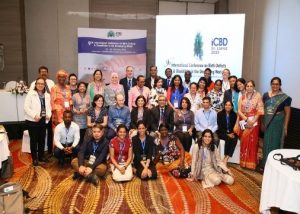

By Nathan Isabirye | Every year health care professionals come together as friends to learn, and to share experiences all over the world in an effort that started a decade ago when the Sixty-third World Health Assembly passed a resolution on Birth Defects in 2010 [WHA63.17 Agenda item 11.7).
This time round, the 9th International Conference on Birth Defects and Disabilities in the Developing World was held in Sri Lanka from 23rd to 26th February 2020 with a theme ‘Accelerating efforts for Birth Defects prevention and care. The conference was deliberated by over 400 leading health care professionals, researchers and representatives from academic, research, government, international development and civil society organizations.
I am a Co – Principal investigator on a March of Dimes funded study project for preconception care. The study aims to explore the current context and feasibility of preconception care service integration in the Ugandan district health system.
Prevalence and etiology of birth defects – experiences from countries
Birth defects (BDs) affect approximately 8 million births annually and account for 11% of neonatal deaths globally. Over 90% of these babies are in low-and middle-income countries. Among those who survive, many experiences lifelong disability. The etiology is largely unknown as 66% causes are multifactorial and unknown. In South -East Asia, major efforts over the past decade have led to a 72% & 62% decline in U5MR & NMR. However, as mortality declines the cause of death changes and birth defects become prominent accounting for 7-30% of under-five 5 mortality across the region. While our main focus on Sustainable Developmental Goals is to reduce maternal and neonatal mortality, all countries should not wait to see birth defects taking a centre stage in causing neonatal death.
Birth defects care and prevention – experiences from countries
Prevention of birth defects is important along the life cycle. Knowing that the period between 3-8 weeks of conception is the most risk time, a life course approach is needed in prevention of birth defects. This is because the current prenatal care plans may be too little too late to prevent error during foetal development. The dual strategy to improve preconception health in LICs through (i) identifying women contemplating pregnancy and improve their health before pregnancy and (ii) population led initiatives to reduce determinants of preconception risks irrespective of pregnancy planning will be a good investment. The current undertakings among countries dedicated to pushing this agenda forward include; food fortification with folate, vitamin B12 and supplementation programs. It is evident that mandatory fortification of cereals with folic acid has a lot of savings on health care. For instance, recent dated study showed that in south Africa -every 1$ spent on fortification there is 30 $ in return from preventing spina bifida.

Countries must ensure that all birth defects are counted to assist policy makers in implementing care and prevention services, empower care takers, link cases to referral for care (surgeries), detecting new teratogens and risk factors and geographical variations in the prevalence of birth defects. Most importantly the concept of triple surveillance to identify the occurrence of the disease, cause & health outcome is key. We also learn that successful surveillance programs have to be built based on the local context and clear objectives must be set & defined. As a way of accelerating efforts for birth defects prevention and care, improving care for affected newborns must appear in the country main objectives. Knowing your land scape helps to align with concerns of the society and proper planning is key (start small but think big). Also, surveillance being a continuous process, you must lobby for your surveillance system through advocacy. Finally, you must build quality in your surveillance system, integrate it into the way professionals work and build champions.
A country experience can be derived from the established RENAC surveillance system in a middle-income country of Argentina. However, notable challenges in low- and middle-income countries where birth defect surveillance programs have been piloted include; the lack of geneticists to do the classification and coding of birth defects. Currently health workers try to do the job, however birth defects are difficult to describe and code accurately. In addition, there are high levels of stigmatization of care takers to infants born with anomalies.
Emerging 9th ICBD REQUESTs to World Health Organization:
Recognizing the need for advocacy for birth defects care and prevention, and in alignment with the Sixty-third World Health Assembly Resolution (2010) on Birth Defects, the participants of the 9th International Conference on Birth Defects and Disabilities in the Developing World requests-
World health Organisation to;
-revisit and review the progress in the implementation of the Sixty-third World Health Assembly Resolution WHA63.17 Agenda item 11.7 (2010)
-reinvigorate global efforts to prioritize birth defects prevention and care in the global health agenda
WHO, international development partners, governments, funders and the global community to dedicate support and resources to;
-establish systems for collection of quality data on birth defects through surveillance, and avail newborn screening, diagnostic, medical and therapeutic services, including genetic testing for birth defects, timely surgeries and ensure continuation of care along the life course.
-develop and implement national policies and concerted programs for birth defects care and prevention
-re-orientate healthcare and public health systems to implement those programs effectively, including policy, guidelines and monitoring for fortification of foods with folic acid and rubella vaccination
-ensure that health care policy and practice for birth defects is based on current scientific evidence
-provide programs and services for improving the health of women and girls before, during and after pregnancy, including those for reducing exposure to harmful and teratogenic substances, including alcohol, drugs and medications
-make available screening and diagnostic services, including genetic testing for birth defects, along the life course
-promote life course approaches for care and prevention of birth defects, stillbirths and preterm birth into primary health care, by addressing risk factors related to lifestyle, infections, and nutrition to ensure access to optimal preconception and prenatal care
-provide initial training and continuing education to healthcare workers at all levels to improve the quality of reproductive, maternal, newborn, adolescent and child health care services, including genetic and genomic education
-encourage and support networking and partnerships, for birth defects care, prevention, advocacy and research.
-educate the public, engage civil society and parents about opportunities to improve birth outcomes through effective use of traditional and social media modalities
-engage civil society and parent/patient organizations for birth defects care, prevention, and advocacy
-implement programs to eliminate stigma and discrimination against persons with birth defects and disabilities
-reorient health & non-health service provider systems to implement concerted programs to optimize living status of persons with disabilities
In conclusion, Makerere University Centre for Excellence for Maternal Newborn Child and Adolescent Health, will commit to mobilising academia in Africa in a collective effort to study the unaddressed challenges & opportunity for birth defect surveillance and care of the affected in the region of Africa. In addition, advocate for newborn screening policies to guide integration of BD surveillance and management into universal health care.
